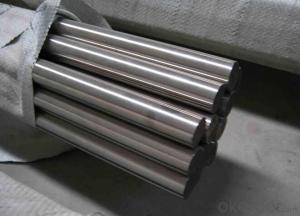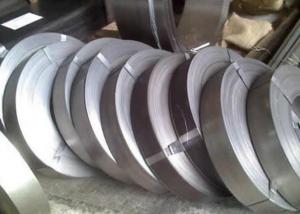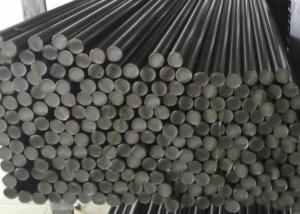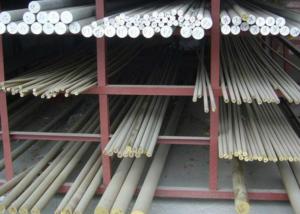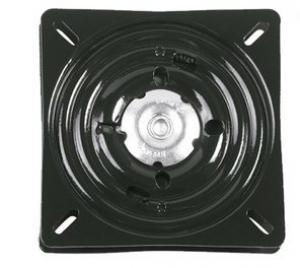42CrMo4 Alloy Structure Steel Round Bar
- Loading Port:
- China main port
- Payment Terms:
- TT OR LC
- Min Order Qty:
- 30 m.t.
- Supply Capability:
- 10000 m.t./month
OKorder Service Pledge
OKorder Financial Service
You Might Also Like
Item specifice
42CrMo4 Alloy Structure Steel Round Bar
Product Information:
Heat treatment
Soft Annealing: Heat to 780-810°C, cool slowly. This will produce a maximum Brinell hardness of 240.
Stress Relieving: Stress relieving to remove machining stresses should be carried out by heating to 650°C, holding for one hour at heat, followed by air cooling. This operation is performed to reduce distortion during heat treatment.
Hardening: Harden from a temperature of 1080-1160°C followed by air, oil or warm bath quenching. Hardness after quenching is 47-53 HRC.
Tempering :Tempering temperature: See the table bellow.
Tempering Temperature (oC) vs. Hardness (HRC)
Specification :
Size:round
Dia:18mm~220mm
Width:60mm-600mm
Heat treatment:Normalized ; Annealed ; Quenched ; tempered
Surface Condition:Black surface ; Grinded ; Machined
Delivery Condition:hot rolled ; cold drawn ; forged
Payment Terms:T/T;L/C
Trade Terms:FOB;CIF
Application:cold work die steel;hot work die steel;plastic die steel
Product Overviews:
| Product Name | Typical Grades | Diameter(mm) | Standard adopted |
| Carbon Steel | 20 (1020/S20C/C22) | Ø16-Ø300 | GB/SAE/JIS/DIN |
| 40 (1040/S40C/C40) | |||
| 45 (1045/S45C/C45) | |||
| Bearing Steel | GCr9 (51100/SUJ1) | Ø12-Ø250 | |
| GCr15 (52100/SUJ2/100Gr6) | |||
| GCr9SiMn (A485-Gr.1/SUJ3) | |||
| Cr-Mo Steel | 20Cr (5120/SCr420H/20Cr4) | Ø12-Ø250 | |
| 40Cr (5140/SCr440/41Cr4) | |||
| 42CrMo(4140/SCM440/42CrMo4) | |||
| Gear Steel | 20CrNiMo | Ø16-Ø600 | |
| 20CrMn(5115/SMnC420/20MnCr5) | |||
| 20CrNiMo(8620/SNCM220/20CrMiMo2) |
Product Show:
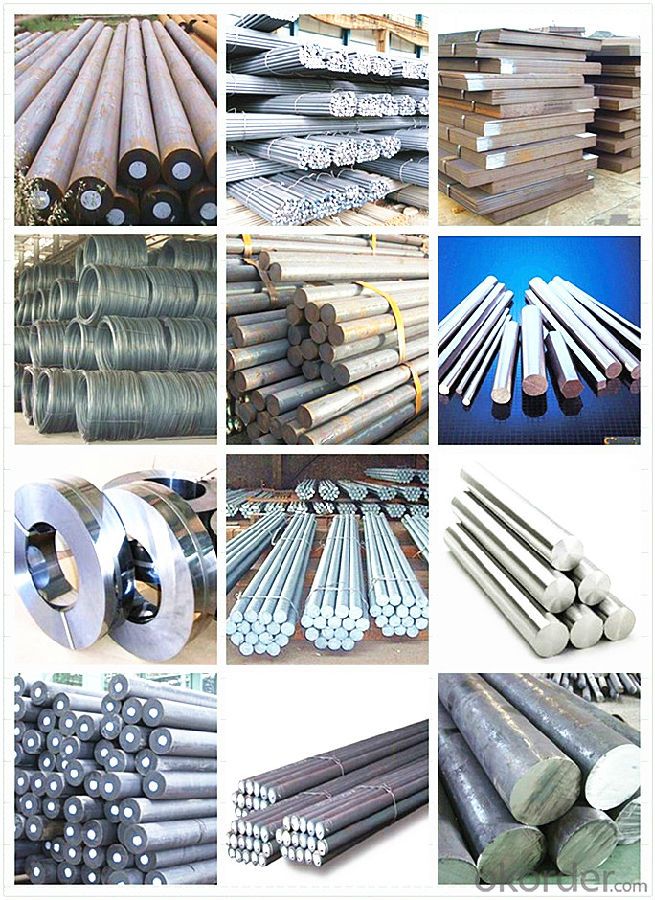
Our Advantages:
· Industry experience over 20 years.
· Shipment of goods -More than 70 countries worldwide.
· The most convenient transport and prompt delivery.
· Competitive price with best service.
· High technical production line with top quality products.
· High reputation based on best quality products.
With our experienced, enthusiastic and dynamic staffs, we assure to bring you the products with best quality, reasonable prices and good after-sales services under the motto: Friends First, Business After.
Communication, Experience, Expertise and Best efforts are our Promises to you.
- Q:What are the different cryogenic grades of special steel?
- There are several different cryogenic grades of special steel that are specifically designed to perform well in extremely low temperature environments. These grades are developed to maintain their mechanical properties and resist brittleness at cryogenic temperatures, making them suitable for applications such as liquefied natural gas (LNG) storage tanks, aerospace equipment, and low-temperature chemical processes. One commonly used cryogenic grade of special steel is the 300 series stainless steel, particularly the types 304 and 316. These stainless steels contain nickel, which enhances their cryogenic toughness and resistance to thermal stress. They are often used in the construction of cryogenic storage vessels and piping systems. Another popular cryogenic grade is the 9% nickel steel. This type of steel is alloyed with around 9% nickel, which provides excellent low-temperature toughness and ductility. 9% nickel steel is commonly used in the construction of LNG storage tanks, as it can withstand the extreme cold temperatures required for the storage and transportation of liquefied natural gas. Additionally, there are special low-temperature carbon steels, such as ASTM A350 LF2 and ASTM A333 Grade 6, which are designed to maintain their toughness and impact resistance at cryogenic temperatures. These steels are often employed in low-temperature applications such as cryogenic piping systems and equipment for the oil and gas industry. In summary, the different cryogenic grades of special steel include stainless steels (such as 300 series stainless steel), 9% nickel steel, and low-temperature carbon steels (like ASTM A350 LF2 and ASTM A333 Grade 6). Each grade is specifically engineered to withstand the challenges posed by extremely low temperatures while maintaining their mechanical properties and resistance to brittleness.
- Q:How is special steel used in the manufacturing of tools and dies?
- Special steel is used in the manufacturing of tools and dies due to its exceptional properties, such as high strength, hardness, and wear resistance. These steels can withstand extreme temperatures and pressures during the forming, cutting, and shaping processes. They also have excellent dimensional stability, ensuring precise and accurate tooling. Special steel's unique composition and heat treatment capabilities allow for the production of durable and long-lasting tools and dies, which are essential for various industries like automotive, aerospace, and manufacturing.
- Q:What is the impact of grain size on the mechanical properties of special steel?
- The impact of grain size on the mechanical properties of special steel is significant. Grain size refers to the size and distribution of individual crystals within the steel structure. It is determined by factors such as the cooling rate during solidification and subsequent heat treatments. In general, a smaller grain size in special steel leads to improved mechanical properties. This is because smaller grains offer a greater number of grain boundaries, which act as barriers to dislocation movement and improve the strength of the steel. Smaller grains also provide a more uniform microstructure, enhancing the overall toughness and resistance to fracture. Additionally, a smaller grain size promotes higher hardness and increased wear resistance in special steel. This is due to the increased number of grain boundaries that hinder the movement of dislocations, preventing plastic deformation and leading to higher hardness values. On the other hand, larger grain sizes can negatively impact the mechanical properties of special steel. Larger grains have fewer grain boundaries, allowing dislocations to move more freely. This results in reduced strength, toughness, and hardness of the steel. Furthermore, larger grains can also lead to anisotropic behavior, where the mechanical properties differ in different crystallographic directions, making the steel more susceptible to failure under certain loading conditions. Therefore, controlling and optimizing the grain size in special steel is crucial to achieve desired mechanical properties. This can be achieved through precise heat treatments, such as annealing or quenching, which control the cooling rate and subsequent recrystallization processes. By controlling the grain size, special steel can be tailored to meet specific application requirements, ensuring optimal mechanical performance and reliability.
- Q:What are the different methods of machining special steel?
- There are several different methods of machining special steel, each with its own advantages and applications. Some of the most common methods include: 1. Turning: Turning is a machining process that involves rotating a workpiece while a cutting tool removes material from the surface. This method is typically used to create cylindrical shapes and can produce high-quality finishes. 2. Milling: Milling is a versatile machining method that uses rotary cutters to remove material from a workpiece. It can be used to create complex shapes and contours, and is often employed in the production of special steel components. 3. Drilling: Drilling is a machining process that involves creating holes in a workpiece using a rotating cutting tool. It can be used to create both through holes and blind holes in special steel, and is commonly used in various industries. 4. Grinding: Grinding is a precision machining method that uses an abrasive wheel to remove material from a workpiece's surface. It is often used to achieve tight tolerances and smooth finishes on special steel components. 5. Broaching: Broaching is a machining process that uses a sharp cutting tool with multiple teeth to remove material in a series of linear cuts. It is commonly used to create keyways, splines, and other intricate shapes in special steel. 6. Electrical Discharge Machining (EDM): EDM is a non-traditional machining method that uses electrical discharges to remove material from a workpiece. It is particularly useful for machining special steel with complex shapes or for creating small features. 7. Laser Cutting: Laser cutting utilizes a high-powered laser to cut through special steel with extreme precision. It is commonly used for intricate designs and can produce smooth edges without the need for subsequent processing. Each of these methods has its own advantages and limitations, and the choice of machining method depends on factors such as the desired outcome, the complexity of the part, and the properties of the special steel being machined.
- Q:What is the significance of alloying elements in special steel?
- Alloying elements in special steel play a crucial role in enhancing its properties and performance. These elements, such as chromium, nickel, manganese, and molybdenum, are added to improve characteristics like strength, hardness, corrosion resistance, and heat resistance. The combination and proportion of alloying elements determine the specific properties of the steel, making it suitable for various applications, such as manufacturing aircraft parts, automotive components, or tools. Overall, alloying elements greatly contribute to the versatility and functionality of special steel.
- Q:What are the requirements for special steel used in construction equipment manufacturing?
- The requirements for manufacturing construction equipment using special steel are strict and specific. Below are some important requirements: 1. Strong: Special steel used in construction equipment manufacturing must have high tensile and yield strength to withstand heavy loads and stresses. This ensures the durability and longevity of the equipment. 2. Toughness: The steel should have excellent toughness to resist fractures and deformations caused by impacts or dynamic loading. This is crucial for construction equipment operating in challenging environments. 3. Resistance to wear: Construction equipment is exposed to abrasive forces such as digging, scraping, and crushing. Therefore, the special steel should have high wear resistance to prevent premature wear and failure. 4. Protection against corrosion: Construction equipment often operates in harsh environments like construction sites, mines, and marine applications. The steel should have good corrosion resistance to prevent rusting and corrosion, which can weaken the equipment's structure. 5. Weldability: Construction equipment manufacturing involves various fabrication processes, including welding. The special steel should be easily weldable to ensure proper joining and structural integrity without compromising strength. 6. Heat resistance: In certain construction applications, equipment may be exposed to high temperatures or thermal cycling. Special steel should have good heat resistance to maintain its mechanical properties and structural stability under these conditions. 7. Ability to be shaped: Construction equipment often has complex shapes and structures. The steel should be easily formable to allow for easy shaping and fabrication of the desired components without compromising its mechanical properties. 8. Cost-effective: While meeting the above requirements, special steel used in construction equipment manufacturing should also be economically feasible. This means balancing the desired properties with the cost of production and procurement. By meeting these requirements, the special steel used in construction equipment manufacturing can withstand demanding conditions, provide long-term durability, and ensure the safety and efficiency of the equipment. Additionally, compliance with industry standards and regulations is crucial to guarantee the quality and reliability of the steel used in construction equipment manufacturing.
- Q:How does tool and die steel maintain its hardness and wear resistance?
- Tool and die steel maintains its hardness and wear resistance through a combination of factors. Firstly, it is made from high carbon content steel, which provides inherent hardness. Additionally, it undergoes heat treatment processes such as quenching and tempering, which further enhance its hardness and wear resistance. These processes involve rapid cooling and reheating to precisely controlled temperatures, transforming the steel's microstructure and creating a fine, uniform grain structure. This refined grain structure improves the steel's hardness and resistance to wear, making it suitable for demanding tool and die applications.
- Q:How does special steel contribute to the oil and gas equipment industry?
- Enhanced strength, corrosion resistance, and heat resistance are crucial attributes of special steel, which plays a vital role in the oil and gas equipment industry. This type of steel is specifically engineered to endure the extreme conditions encountered during oil and gas exploration, extraction, and processing. The superior strength of special steel is one of its primary advantages in this industry. Oil and gas equipment, such as drill pipes, wellheads, and pipelines, are subjected to high pressure, heavy loads, and harsh environments. Thanks to its high tensile and yield strength, special steel ensures that these components can withstand such demanding conditions without experiencing failures, thus guaranteeing the safety and reliability of the equipment. Another significant benefit of special steel in the oil and gas equipment industry is its corrosion resistance. The extraction and transportation of oil and gas involve exposure to corrosive substances, such as hydrogen sulfide, carbon dioxide, and saltwater. Special steel is specifically designed to resist corrosion, thereby minimizing the risk of equipment degradation, leaks, and costly maintenance. Furthermore, special steel possesses excellent heat resistance properties. The oil and gas industry often operates equipment at high temperatures during processes such as oil refining, gas compression, or steam injection. The ability of special steel to withstand high temperatures without compromising its mechanical properties makes it an ideal choice for critical components like valves, heat exchangers, and turbines. The use of special steel also enables the oil and gas industry to explore and extract resources from challenging environments. Offshore drilling rigs, for instance, encounter harsh conditions such as strong waves, saltwater exposure, and extreme temperatures. Special steel's resistance to these environmental factors ensures the durability and longevity of offshore equipment. In conclusion, special steel significantly contributes to the oil and gas equipment industry by providing enhanced strength, corrosion resistance, and heat resistance. By employing this type of steel, the industry can ensure the reliability, safety, and longevity of its equipment, ultimately improving operational efficiency and reducing downtime.
- Q:What are the different mining grades of special steel?
- The different mining grades of special steel can vary depending on the specific composition and properties required for different applications. Some common mining grades include stainless steel, tool steel, high-speed steel, and alloy steel. Each grade has unique characteristics that make it suitable for specific mining operations, such as resistance to corrosion, high strength, hardness, and wear resistance.
- Q:What are the different methods of surface electropolishing for special steel?
- Special steel can undergo surface electropolishing using various methods, each with its unique benefits and applications. 1. Immersion Electropolishing: To achieve a smooth and polished finish, the special steel components are immersed in an electrolyte bath, and a direct current is passed through the solution. This method is ideal for large and complex parts, offering uniform surface improvement on all exposed areas. 2. Electrolytic Electropolishing: By applying a direct current directly to the surface of the special steel component using an electrode, the surface dissolves, resulting in a reflective and smooth finish. This technique allows precise control over the process and is suitable for smaller or intricate parts, targeting specific areas that require improvement. 3. Reverse Pulse Electropolishing: A combination of direct and reverse current pulses is utilized to achieve an exceptional surface finish. The reverse current pulses reduce surface roughness and eliminate embedded particles or contaminants. This method is especially beneficial for special steel components that require enhanced corrosion resistance and improved cleanliness. 4. Magnetic Field-Assisted Electropolishing: Applying a magnetic field to the electropolishing process can enhance the polishing rate and surface finish. The alignment of the electrical current by the magnetic field improves material removal, resulting in a smoother and more uniform surface. This method is preferred for difficult-to-polish special steels or those with complex geometries. 5. Flow-Assisted Electropolishing: By using a flowing electrolyte solution, the electropolishing process is enhanced. The flowing solution aids in removing dissolved material from the surface and prevents the formation of gas bubbles, resulting in a more efficient and smoother polishing. This method is suitable for large or flat special steel components requiring a high-quality surface finish. In conclusion, the choice of the appropriate method for surface electropolishing of special steel depends on specific component requirements, such as size, geometry, and desired surface finish. Each method has its advantages and considerations, and seeking guidance from an experienced electropolishing specialist is advisable to determine the most suitable approach.
1. Manufacturer Overview |
|
|---|---|
| Location | |
| Year Established | |
| Annual Output Value | |
| Main Markets | |
| Company Certifications | |
2. Manufacturer Certificates |
|
|---|---|
| a) Certification Name | |
| Range | |
| Reference | |
| Validity Period | |
3. Manufacturer Capability |
|
|---|---|
| a)Trade Capacity | |
| Nearest Port | |
| Export Percentage | |
| No.of Employees in Trade Department | |
| Language Spoken: | |
| b)Factory Information | |
| Factory Size: | |
| No. of Production Lines | |
| Contract Manufacturing | |
| Product Price Range | |
Send your message to us
42CrMo4 Alloy Structure Steel Round Bar
- Loading Port:
- China main port
- Payment Terms:
- TT OR LC
- Min Order Qty:
- 30 m.t.
- Supply Capability:
- 10000 m.t./month
OKorder Service Pledge
OKorder Financial Service
Similar products
New products
Hot products
Related keywords
